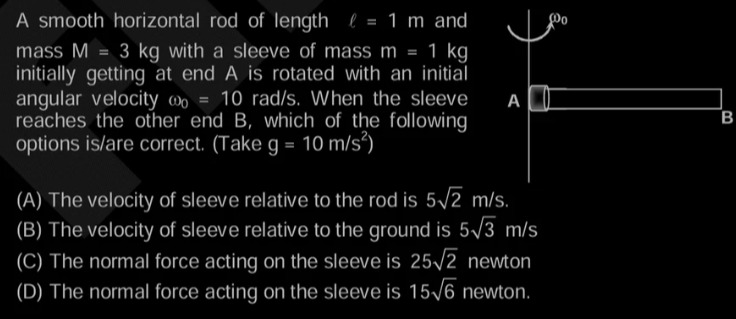Question
Question: A smooth horizontal rod of length $\ell$ = 1 m and mass M = 3 kg with a sleeve of mass m = 1 kg init...
A smooth horizontal rod of length ℓ = 1 m and mass M = 3 kg with a sleeve of mass m = 1 kg initially getting at end A is rotated with an initial angular velocity ω0 = 10 rad/s. When the sleeve reaches the other end B, which of the following options is/are correct. (Take g = 10 m/s²)

The velocity of sleeve relative to the rod is 52 m/s.
The velocity of sleeve relative to the ground is 53 m/s
The normal force acting on the sleeve is 252 newton
The normal force acting on the sleeve is 156 newton.
A, B, C
Solution
The system consists of a horizontal rod of length ℓ and mass M, rotating about a vertical axis at one end A, and a sleeve of mass m sliding along the rod. Initially, the sleeve is at end A, and the rod rotates with an angular velocity ω0. The rod is smooth, so there is no friction between the sleeve and the rod. Since the rod is horizontal, gravity does not affect the motion in the horizontal plane. We assume that there is no external torque applied about the axis of rotation, so the angular momentum of the system about the axis of rotation is conserved.
Let r be the distance of the sleeve from the axis of rotation. The moment of inertia of the rod about the axis is Irod=31Mℓ2. The moment of inertia of the sleeve about the axis is Isleeve=mr2. The total moment of inertia of the system is I=Irod+Isleeve=31Mℓ2+mr2. The angular momentum of the system is L=Iω=(31Mℓ2+mr2)ω. Initially, at end A, r=0 and ω=ω0. The initial angular momentum is L0=(31Mℓ2+m(0)2)ω0=31Mℓ2ω0. When the sleeve reaches end B, r=ℓ. Let the angular velocity be ωf. The final angular momentum is Lf=(31Mℓ2+mℓ2)ωf. By conservation of angular momentum, Lf=L0. (31Mℓ2+mℓ2)ωf=31Mℓ2ω0 ℓ2(31M+m)ωf=31Mℓ2ω0 ωf=31M+m31Mω0=M+3mMω0. Given M = 3 kg, m = 1 kg, ω0 = 10 rad/s. ωf=3+3(1)3×10=63×10=5 rad/s.
Now, we use conservation of mechanical energy. The initial kinetic energy is the rotational kinetic energy of the rod. The sleeve is initially at rest relative to the rod at r=0, so its initial kinetic energy is zero. K0=21I0ω02=21(31Mℓ2)ω02. When the sleeve reaches end B, its kinetic energy consists of rotational kinetic energy and translational kinetic energy relative to the rod. The kinetic energy of the rod is 21Irodωf2=21(31Mℓ2)ωf2. The kinetic energy of the sleeve is 21Isleeve,fωf2+21mvr,f2=21mℓ2ωf2+21mvr,f2, where vr,f is the radial velocity of the sleeve relative to the rod at end B. The total final kinetic energy is Kf=21(31Mℓ2+mℓ2)ωf2+21mvr,f2. By conservation of energy, Kf=K0. 21(31Mℓ2+mℓ2)ωf2+21mvr,f2=21(31Mℓ2)ω02. (31M+m)ℓ2ωf2+mvr,f2=31Mℓ2ω02. Substitute ωf=M+3mMω0. (3M+3m)ℓ2(M+3mMω0)2+mvr,f2=31Mℓ2ω02. 3(M+3m)M2ℓ2ω02+mvr,f2=31Mℓ2ω02. mvr,f2=31Mℓ2ω02−3(M+3m)M2ℓ2ω02=3(M+3m)M(M+3m)−M2ℓ2ω02=3(M+3m)3Mmℓ2ω02=M+3mMmℓ2ω02. vr,f2=M+3mMℓ2ω02. vr,f=M+3mMℓω0. Substitute the given values: M = 3 kg, m = 1 kg, ℓ = 1 m, ω0 = 10 rad/s. vr,f=3+3(1)3×1×10=63×10=21×10=210=52 m/s. (A) The velocity of sleeve relative to the rod is 52 m/s. This is correct.
The velocity of the sleeve relative to the ground has two components: the radial velocity relative to the rod vr,f and the tangential velocity due to the rotation vt,f=ℓωf. These two components are perpendicular. vt,f=ℓωf=1×5=5 m/s. The magnitude of the velocity of the sleeve relative to the ground is vground=vr,f2+vt,f2=(52)2+52=50+25=75=53 m/s. (B) The velocity of sleeve relative to the ground is 53 m/s. This is correct.
The normal force acting on the sleeve is the force exerted by the side of the rod on the sleeve. This force is perpendicular to the rod and the axis of rotation, and it provides the centripetal force for the sleeve's tangential acceleration in the inertial frame. In the rotating frame, this force is in the tangential direction. The tangential equation of motion for the sleeve in the rotating frame is N=m(rω˙+2r˙ω), where N is the normal force from the side of the rod. From angular momentum conservation, (31Mℓ2+mr2)ω=L0. Differentiating with respect to time, (2mrr˙)ω+(31Mℓ2+mr2)ω˙=0. ω˙=−31Mℓ2+mr22mrr˙ω. At end B, r=ℓ, r˙=vr,f, ω=ωf. ω˙f=−31Mℓ2+mℓ22mℓvr,fωf=−ℓ2(31M+m)2mℓvr,fωf=−ℓ(31M+m)2mvr,fωf. The normal force at end B is Nf=m(ℓω˙f+2vr,fωf). Nf=m(ℓ(−ℓ(31M+m)2mvr,fωf)+2vr,fωf)=m(−31M+m2mvr,fωf+2vr,fωf)=mvr,fωf(2−31M+m2m)=mvr,fωf(2−M+3m6m). Substitute the values: m=1 kg, vr,f=52 m/s, ωf=5 rad/s, M=3 kg. Nf=1×52×5(2−3+3×16×1)=252(2−66)=252(2−1)=252×1=252 newton. (C) The normal force acting on the sleeve is 252 newton. This is correct. (D) The normal force acting on the sleeve is 156 newton. This is incorrect.
Final check: Option A: vr,f=52 m/s. Correct. Option B: vground=53 m/s. Correct. Option C: Nf=252 N. Correct. Option D: Nf=156 N. Incorrect.
